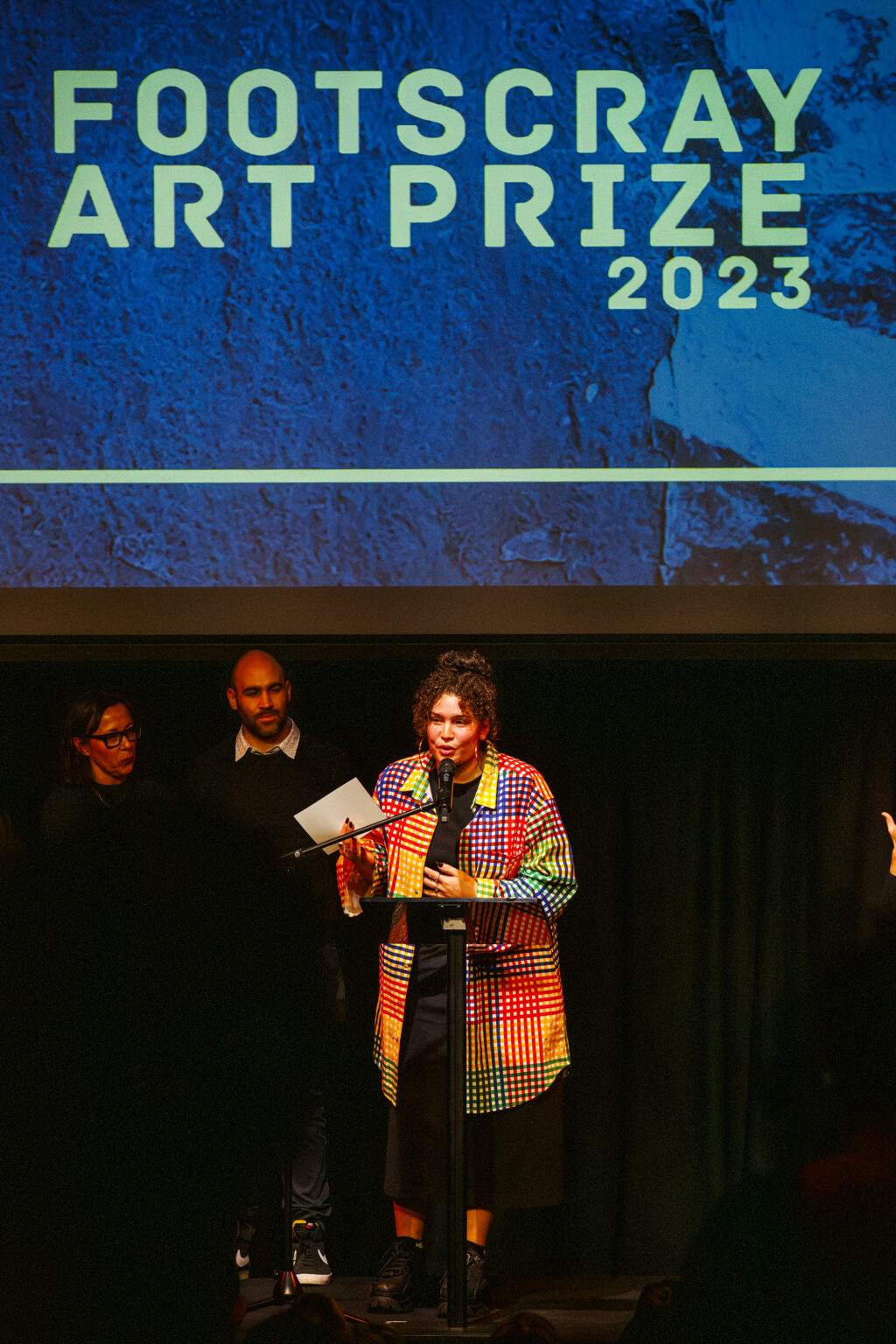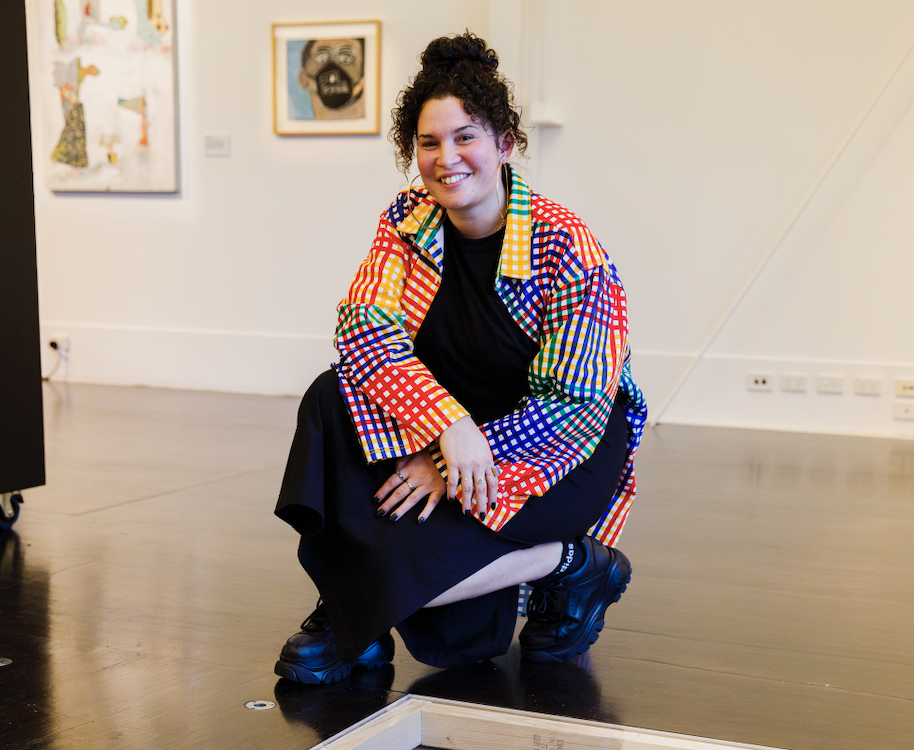The success of Roberta’s work is not only the power of its subject and elements but how she has implicated us as viewers of the work.
Multi-disciplinary artist Roberta Joy Rich was recently awarded the Footscray Art Prize 2023 for her powerful and multi-layered video installation entitled ‘Though Buried, They Echo’.
We caught up with Roberta to discuss the winning piece; what role lived experience plays in art; and what change she is hoping to create in people.

Introduce yourself and your winning work
My name is Roberta Joy Rich and I am a multi-disciplinary artist, curator and educator. My practice often references my own diaspora southern African identity and experiences, as well as African resistance histories and Bla(c)k narratives.
I’m interested in the process of re-framing materials to unearth silenced histories, and in doing so, what possibilities they conjure. I utilise historical and personal archives, storytelling, photo-media, text and satire in the form of video, sound, installation and mixed media practices in my work, with the hope to deconstruct colonial modalities and propose sites of self-determination.
The work presented in the 2023 Footscray Art Prize is called Though Buried, They Echo. I created this work during COVID lockdowns that was presented in 2022 as part of a new installation and exhibition titled “The Purple Shall Govern” at Footscray Community Arts. The exhibition explored and aimed to highlight the stark parallels of the Apartheid’s endured by Bla(c)k folk in the nation states of South Africa and Australia.
The figures visible on a broadcast monitor situated beneath the transparent floor are Arthur Cawell, Sir Robert Menzies, Joh Bjelke-Peterson, Hendrik Vervoed, Johannes Strijdom and Pieter Willem Botha, seen in various media interviews. I have silenced their voices and placed them in the foundations and depths of the gallery’s structure among Footscray Community Art’s archives. These men have all significantly contributed to White supremacist policies in Australian and South African colonial law concerning the freedom and rights of Bla(c)k peoples that continue to inform social attitudes and economic positionality today.
I wanted to create a work that acknowledges the realities of our past and speak back to it without heralding these men. People are quick to think of South Africa when the word Apartheid is mentioned for obvious reasons, but these laws originate from Australia and we need to acknowledge our proximity to it and its ongoing systemic violence.

How does your lived experience as a diaspora southern African raised on Wathaurong country influence your art?
Growing up on Wathaurong country, I was always intrigued about my family, how we came to be and what our history entailed.
Growing up, my parents didn’t share much about what had happened and what was happening in South Africa. We knew we were South African, but we didn’t talk about the political climate. My peers would also make it very apparent that we were “different.”
Wanting to understand more about my history fed my thirst for knowledge and in turn influenced my interest in social justice and histories beyond the self.
I subconsciously gravitated towards the so-called “oddballs”, the working class folk, First Nations and People of Colour. Now, a little older I recognise I was yearning for connection and safety within the colonial noise. The more I learned about First Nations histories, the more I recognised similarities, and felt inspired by Blak folk and a responsibility to share my stories and have difficult conversations through art.
Growing up on Wathaurong country in the 90’s and 00’s was challenging, but it has shaped my being, practice and critical thinking. I am grateful for that.
After viewing “Though Buried, They Echo.” – what do you hope changes in people?
I hope the work can encourage viewers to think deeply about the historical and ongoing structural violence in governance and its place within society currently.
The colonial project in the nation states of South Africa and Australia continues, where segregation policies and immigration laws implemented by these very policy makers reflect the economic, social and health currency of Bla(c)k communities today.
I hope when people view this work, they can reflect on their own experiences and relationship to Bla(c)k justice and consider what tangible actions may be within one’s capacity to shift a culture of thinking, of a shameful past.

In what ways will winning the Footscray Art Prize empower you as an artist, and transform your practice?
It is the first ever Art Prize I have won in my life, a life of 10 years of making art!
I feel like prizes sometimes can contribute to linear ideals of ‘a way to success’ in the arts, so I imagine for those who think in that trajectory, they might take my practice more seriously now.
In all seriousness though, the funds from this generous award can alleviate the stress artists encounter and bolster my ability to do projects I am passionate about but haven’t had the resources to explore.
I also think it’s important to reward oneself with some healthy time away from the studio.
It feels special to be recognised by Footscray Arts Centre and the judges for this work. To be awarded from an institution that centres First Nations, access, People of Colour, queer and working-class folk feels apt in an industry I have been working hard within.
Now for some lighter, quick-fire questions:
First thing you said when you found out you won?
That would be inappropriate for this news!
One piece of advice for other up-and-coming artists:
I found solace in being creative and naively pursued art with great passion instead of a degree that would guarantee a paid job. I went rogue after art school to find my people and do the shitty jobs along the way.
It hasn’t been easy, but if you can find ways to continue making art you are passionate about, with time the rest will find a way, and delightful moments will come your way. Unavoidably, you will learn through hardships what works best for you.
A book recommendation:
I’m very biased because of my recent residency in Indonesia but Isna Marifa’s Mountains More Ancient was one of the fastest books I have read in a long time. Informed by historical research concerning slave histories of my peoples, it is a re-imagining of a daughter and father who become enslaved by the Dutch VOC and forced to depart Java for life in the Cape of Good Hope.
Read more about Roberta’s journey on her website: http://www.robertajoyrich.com/
Make sure to check out Footscray Art Prize activated across all our gallery spaces until 17 September 2023.
To learn more about Footscray Art Prize, visit our event webpage here!
Image credits: Gianna Rizzo Photography

